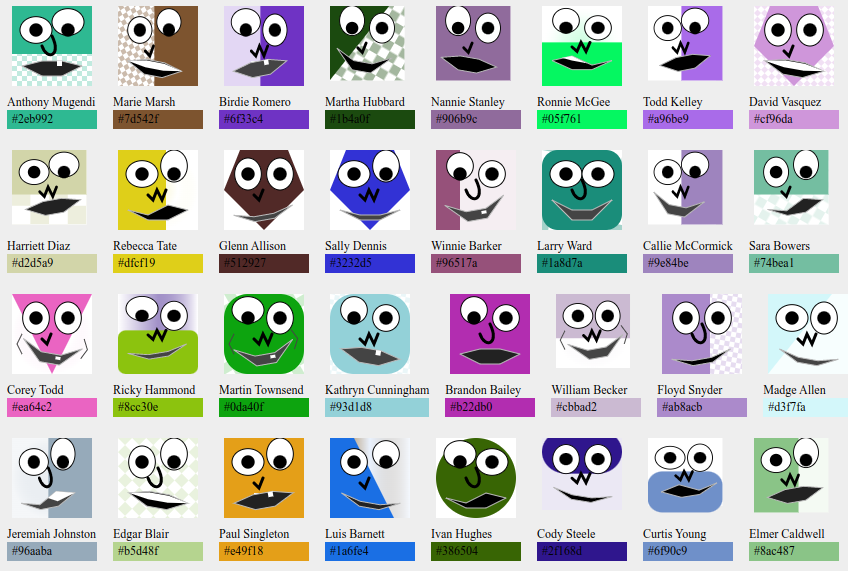facitars v1.0.1
Facitars!

Lightweight avatar generator for the browser and server (NodeJs) that creates colorful and gender neutral avatars and also conveniently returns the avatars primary color too!
Facitars was built after I tried dozens of others and couldn't find one that provided support for all of the following:
Creating lightweight (no complex curves and paths) SVG avatars with the help of SVG.js. The minified javascript file is only 17.8 KBs of awesomeness!
Generating and Returning a unique (seed generated) color for each avatar. This is useful for applications where you wish to color code certain parts of your UI based on a users ID/email or whatever your seed value may be.
Most importantly, this project is generates SVG avatars both in the browser and on the server in a consistent manner. To do so, it relies on JSDOM and SVG.js while avoiding SVG operations that would produce inconsistent SVGs on browser and server. This means that facitars goes beyond other avatar generators out there!
Finally, all avatars generated should be of the same size so as to fit well in grids and UIs
Generating Facitars on the Browser
On the browser all you need is:
1. Load the js file
<!-- Add this line preferably to your <head> -->
<script src="../dist/facitars.min.js"></script>Note that Facitars uses SVG.js. Consequently the minified svg.js file from jsdelivr will be automatically loaded if no instance of
window.SVGis found.If svg.js has already been loaded prior to loading facitars, then that instance is used.
2. Initialize the class
<script>
// init
const facitars = new Facitars();
</script>3. Generate your Facitar
<script>
// Note generate() function is asynchronous
(async () => {
// create 300x300px facitar for the seed 'Anthony Mugendi'
let { svg, color } = await facitars.generate('Anthony Mugendi', 100);
// use the svg and color values returned as you desire
})();
</script>Generating Facitars on the Server
1. Require Facitars
Of course start with installing facitars yarn add facitars
// require
const Facitars = require('facitars').node();Note: You must call
.node()when using on the server. This method wraps in JSDOM which is used to mock browser svg rendering.For the server version. A local version of svg.js is included. This is because we cannot trust any scripts from jsdelivr or any other source as JSDOM is known to leak its sandbox.
2. Initialize the class
// init
const facitars = new Facitars();3. Generate your Facitar
// Note generate() function is asynchronous
(async () => {
// create 300x300px facitar for the seed 'Anthony Mugendi'
let { svg, color } = await facitars.generate('Anthony Mugendi', 100);
// use the svg and color values returned as you desire
})();Using Facitars with Webpack and other package managers
// simply require facitars
const Facitar = require('facitars').browser();
// proceed to use as desired
const facitar = new Facitar();Note: Ensure you call
.browser()not.node()as JSDOM is not needed, nor would it work anyway, in a browser environment. Also.browser()provides only the facitar class and therefore is perfect for your tree-shaking.For Server renders, you can write the SVG data returned to an svg file for later serving via HTTP or any other use. See the Node Example folder for more.
For both browser and server examples above, the following Facitar is generated against the seed "Anthony Mugendi" 🙂

API
.generate(seed,size)
The seed can be any value so long as it can be converted into a string using seed.toString().
The size argument determines the dimensions of the final SVG. Default is 80.
Examples
Have a look at Browser Example as well as the NODE/Server Examples for more.